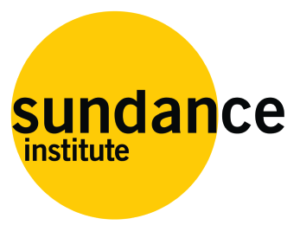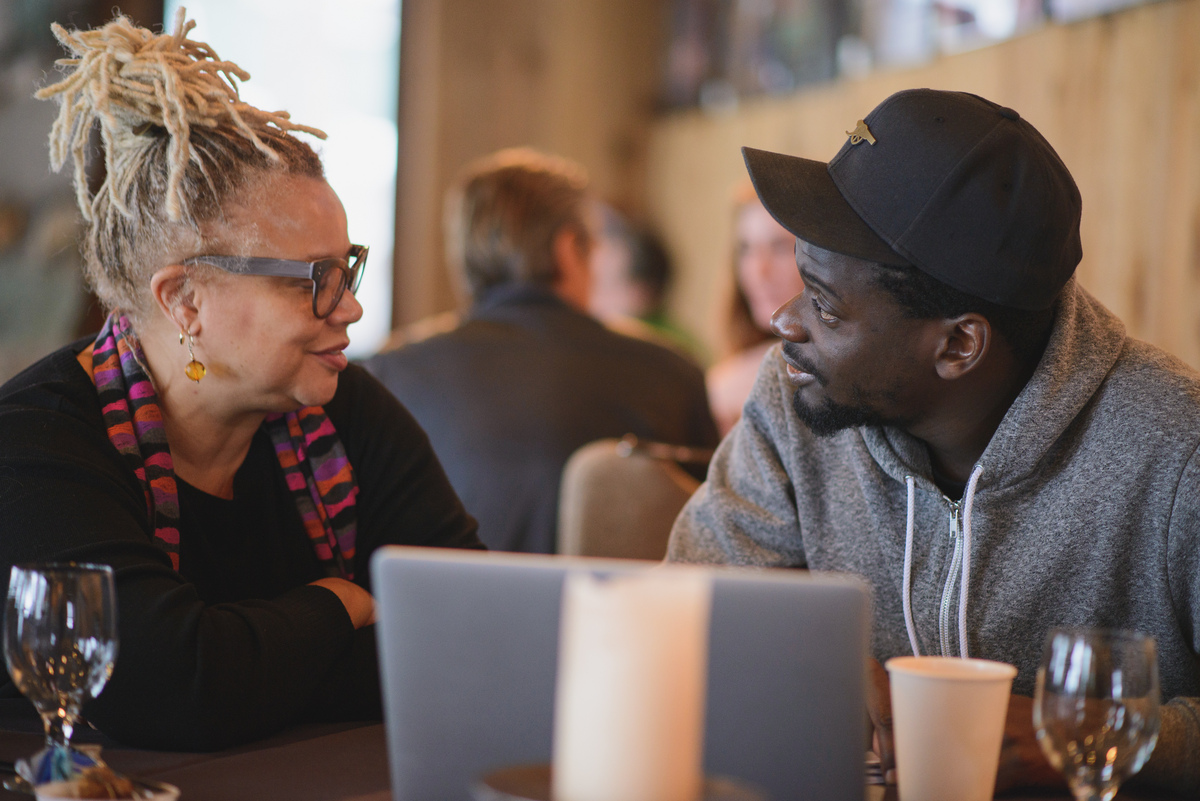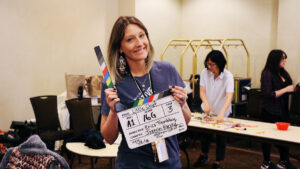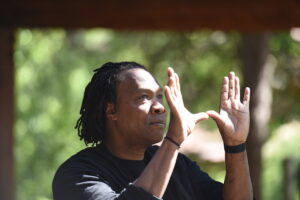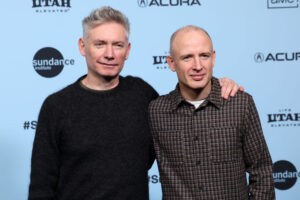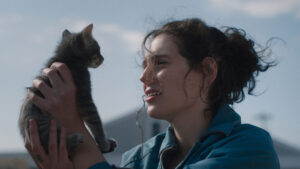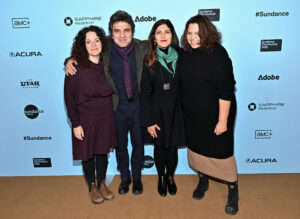Kasi Lemmons with fellow Daniel Kaluuya at Sundance Institute’s 2016 January Screenwriters Lab. Photo by Brandon Cruz for Sundance Institute
By Lucy Spicer
Writer-director, actor, and teacher Kasi Lemmons (Eve’s Bayou, Harriet) has a long history with Sundance Institute: She’s been a creative advisor at more than 25 Institute labs since 2000, and she premiered her sophomore feature film, The Caveman’s Valentine, at the Sundance Film Festival in 2001. But she’s never been a Sundance Institute lab fellow. “No, I’ve never been a fellow,” says Lemmons in a Zoom meeting. “I have fellow envy! I wish I could be — now, even.”
So what is it about a Sundance Institute lab that could inspire envy in such a seasoned film professional? According to Lemmons, it’s the unparalleled level of attention that fellows receive from creative advisors. “It’s interesting, because I teach at film school and I’ve also been doing the labs for a really long time,” she explains. “To me, I bring my philosophy to both places. I think what it’s difficult to get at a film school is the level, first of all, of intense focus on the filmmaker’s project, but also, honestly, the caliber of advisors,” she continues. “I mean, this is incredible. I often tell fellows, ‘I wish I could get Scott Frank to read my script.’” Like Lemmons, Frank has been a fixture at Sundance Institute’s Directors and Screenwriters Labs for years, and he’s not alone. Ed Harris, John August, Joan Darling, Joan Tewkesbury, and more return frequently to help nurture early-career filmmakers who arrive at the labs with unique stories.
Lemmons is back as a creative advisor at the 2025 Directors Lab, where emerging filmmakers are paired with experienced advisors to workshop scenes from their original projects. And though she’s attended more than two dozen Directors and Screenwriters Labs, Lemmons keeps coming back for a reason. “It’s stayed amazingly consistently original and fresh and diverse. I think it’s really maintained its originality,” she explains. “I think that it’s become even more wonderfully diverse, I would say, and I hope that that is something that continues now with this kind of war on diversity and diverse ideas.
“We would be looking to Sundance to really be a stronghold against that kind of thinking,” she continues. “Obviously we need diversity in all areas, but film, I always say, needs to represent who we are. Like if you put it in a time capsule, you know, and future civilizations could come and look at it, it should really reflect who we are and all of our complications and beauty and diversity. So I’ve always felt that it’s extremely necessary, right? You don’t want the culture keepers to look like all one thing.”
But before these films can be put in a time capsule, they have to come together. And the labs exist so that filmmakers can bring their projects to a community that gathers for the purpose of focusing on the artistic process as opposed to a finished product. “I think that Sundance makes a big effort to seek out underrepresented voices and stories that are a little off the beaten path,” says Lemmons. “And we see these stories be successful over and over again, but it takes, you know, a little incubation and a place where these ideas can be nourished and where they’re seen as valuable before, you know, they win awards and the whole world sees them as valuable.”
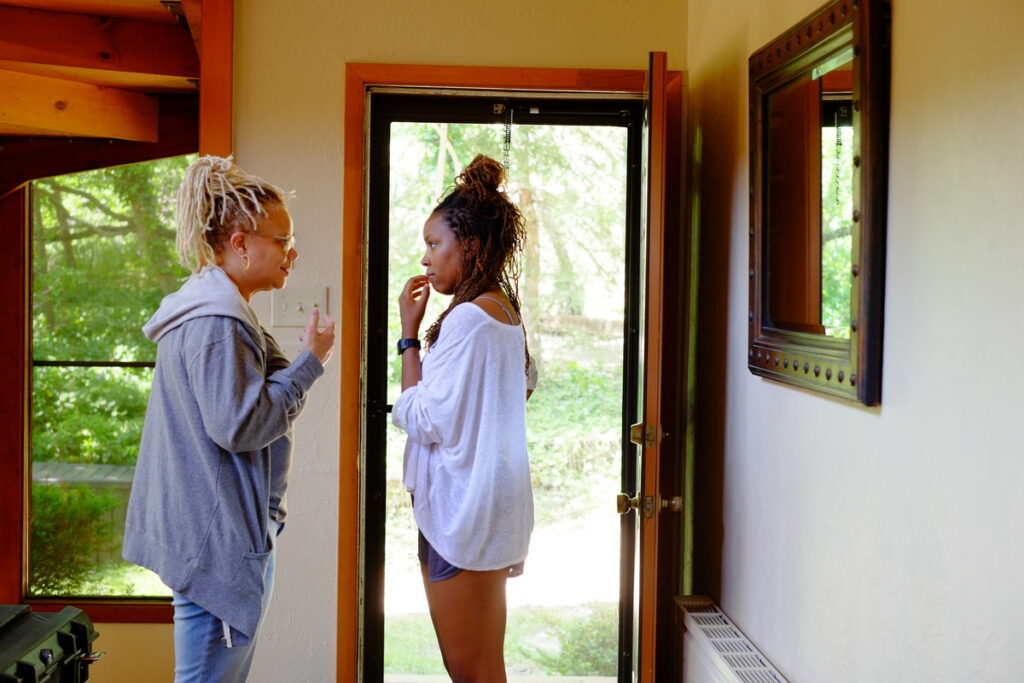
The Institute’s Directors Lab has seen no shortage of projects that would go on to receive wide acclaim over the years — films like Boys Don’t Cry, Reservoir Dogs, A Thousand and One, and Beasts of the Southern Wild. And the creative advisors remember when they encounter a story destined to change a filmmaker’s life. “I remember Nia DaCosta and Little Woods, just thinking, ‘This is a career, like, I can see it,’ you know?” says Lemmons. “I remember Beasts of the Southern Wild,” she recalls. “I’d say Beasts of the Southern Wild was one of those where I was like, ‘This is one of the most amazing layered stories,’ … The most wonderful thing, honestly, is that sometimes you see a script and you’re like, ‘Huh, this is different. This is wonderful. This is wow.”
When advising at the labs means getting the chance to mentor such exciting filmmakers and help their stories blossom, who wouldn’t want to keep coming back year after year? “I think it’s a beautiful, formative experience,” says Lemmons. “When I am at Sundance, in those rooms, we’re in the dining hall or whatever, and you look at all the posters on the walls of the movies that have come through Sundance, you realize how important but also integral it is to the beauty of the film industry. When we think of the films that we love, many of them have come through the Institute.
“It’s an incredibly nurturing experience, and it doesn’t end, right?” she continues. “I mean, these are always ongoing relationships that we make there, and Sundance’s support I know is ongoing for these filmmakers. I always think they’re the luckiest people on Earth, you know?”
Considering cinema’s potential for cultural impact, some may be surprised to learn that a group of advisors volunteering their time would be seen as an anomaly in the industry. But, according to Lemmons, that’s still what sets the Sundance Institute labs apart, even 45 years after Robert Redford first envisioned the programs.
“I have told many people — it’s kind of a magic experience in ways that are hard to define,” says Lemmons of the labs. “There’s something that you get from the community. … You know, you’re so lucky to have your work read by these people and to have them focusing on your work and how to help you. When would you ever just be around that group of people and to have them — everybody, really — in a very genuine, openhearted way, giving their time to volunteer work, right? Just giving their time for your art. I mean, that’s a profound and singular kind of experience, you know. People that don’t have any agenda, but just helping to foster a new generation of artists. It’s a very unique and special experience.”
